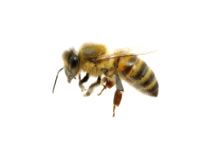
Australian operated

5.0
30 reviews

5.0
30 reviews

Australian operated
Free on-site visit & quote
Over 14,000+ homes protected
5/5 stars is most frequent rating
Stinging insects, such as mud wasps, paper wasps, and bees, can pose significant risks to humans and pets due to their painful stings and potential allergic reactions. These insects play important roles in the environment but can become a danger when they build nests around homes and businesses. Understanding the behavior, habitat, and risks of these stinging pests is essential to managing them safely. Whether it’s the mud wasp collecting mud for its nest or the paper wasp defending its hive, their stings should not be underestimated. In this section, we explore each of these stinging insects, the danger they pose, and how to deal with them effectively.
Mud wasps are a large, black and yellow banded stinging pest found in various regions of Australia. Typically measuring 2.5 cm in length, these wasps are often seen around damp soil areas, pools, and birdbaths. They are known for their unique behavior of collecting mud to construct their nests. Unlike paper wasps or hornets, mud wasps do not build their nests from fibers but instead use mud, which they carry in small loads back to the nest location. This method of nest-building makes them highly efficient at creating sheltered homes that are resistant to the elements.
Mud wasps are solitary predators that feed primarily on spiders. Once they capture a spider, they paralyze it, then push it into the mud nest where they lay an egg on top of the spider. When the egg hatches, the larvae feed on the spider, allowing them to grow until they emerge as adult wasps. The nests are typically built on external brickwork or the framing of homes, especially in areas where there is access to mud and a steady supply of spiders. These wasps are found across Australia and generally avoid human contact, preferring to focus on nest construction and food gathering. However, their nests should still be approached with caution.

Danger to Humans
While mud wasps rarely attack humans, they can still deliver a painful sting if provoked or if someone gets too close to their nest. Their sting can cause swelling and discomfort, but it typically isn’t life-threatening. If stung, apply an ice pack to the affected area to reduce pain and swelling. In the rare case of an allergic reaction, such as difficulty breathing, swelling of the face or throat, or severe pain, immediate medical attention should be sought.
Paper wasps are generally smaller than mud wasps, ranging in size from 1.8 cm to 2.5 cm in length. These wasps are less aggressive than hornets, but they will defend their nests if they feel threatened. Paper wasps are commonly found in subtropical and tropical climates, with about 300 species identified worldwide. They construct their nests using plant fibers and dead wood, which they mix with their saliva to create a water-resistant structure. This nest typically resembles an open comb, and it is commonly found in eaves, underneath rooflines, in pipes, or on tree branches.
These wasps are also beneficial to the environment as they help pollinate plants while feeding on nectar. In addition to nectar, paper wasps feed on small insects, including flies, beetle larvae, and caterpillars, which makes them natural predators of many garden pests. Despite their benefits, paper wasps can become a problem when they nest too close to homes or public spaces.

Danger to Humans
Though paper wasps are not inherently aggressive, they can deliver a painful sting when their nest is disturbed. For some individuals, the sting can result in a serious allergic reaction, including anaphylaxis, which can be life-threatening. Symptoms of a paper wasp sting can include severe swelling, itching, and pain at the site of the sting, and in more severe cases, difficulty breathing, dizziness, and swelling of the face or throat. If stung, it’s important to monitor for signs of an allergic reaction and seek immediate medical attention if necessary.
Bees play a vital role in pollination and are essential to maintaining ecosystems by enabling the growth of many plants, crops, and flowers. There are over 20,000 species of bees around the world, with the honeybee and bumblebee being the most commonly known. Bees have long tongues that allow them to feed on nectar from flowers. They are also covered in tiny hairs on their thick bodies, which helps them collect pollen as they move from flower to flower, making them important pollinators.

Danger to Humans
While bees are typically non-aggressive, they will sting if they feel threatened or if their hive is disturbed. For most people, a bee sting results in mild pain and swelling that fades after a few hours. However, some individuals are highly allergic to bee venom, which can lead to severe reactions. Symptoms of an allergic reaction include:
If any of these symptoms occur, it’s essential to seek medical attention immediately to prevent anaphylaxis. In cases of mild stings, it’s important to avoid scratching the area and to apply an ice pack to reduce swelling.
Stinging pests such as mud wasps, paper wasps, and bees can be both dangerous and disruptive when they nest near your property. Whether it’s managing the risk of stings, preventing allergies, or protecting your home from damage, early intervention is key. Professional help from Pest Ex ensures that wasp nests and bee hives are safely removed, reducing risks to your family and pets. Our experts use the latest tools and techniques to eliminate stinging pests and prevent future infestations.
Contact Pest Ex today for reliable and safe stinging pest control services.







